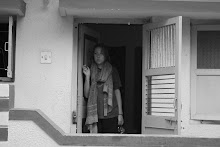With the last dusty turn of the desert road with no name, we reach the village of Ajrakhpur. There’s a lot to see.
Okay wait.
To my left, men are knee deep in a concrete water tank pounding, ringing, and rinsing cotton material. Next to them, meters and meters of fabric are being laid out on the dirt ground to bake in the Kachchh desert solar oven. To my right, fabric is being dipped into barrels of dark midnight dye. Dye that’s mixed over the blazing fires being stoked nearby. It’s only a few more meters before we pass the crops of indigo cultivated to make that dye.
Okay wait.
I can’t remember it all that well, but do you know the Disney Pirates of the Caribbean ride? How as the ride leisurely takes you along, you witness little scenes of the life of pirates?
So there’s zero resemblance to a pirate’s life in Ajrakhpur.
BUT I’m reminded of the ride because as we slowly drive through and catch a snapshot of all the different ongoing activities, that’s what it feels like. [Now if you will please exit the world of Disney and enter the village of Ajrakhpur.]
To my left, men are knee deep in a concrete water tank pounding, ringing, and rinsing cotton material. Next to them, meters and meters of fabric are being laid out on the dirt ground to bake in the Kachchh desert solar oven. To my right, fabric is being dipped into barrels of dark midnight dye. Dye that’s mixed over the blazing fires being stoked nearby. It’s only a few more meters before we pass the crops of indigo cultivated to make that dye.
The car stops. Outside the home of the artisan we’re here to meet, a man is sitting on the ground carving intricate designs into a block of wood with rudimentary tools. Inside the house, a number of artisans are printing, block by intricately carved block, beautiful patterns onto the textiles that will be rinsed in those concrete tanks, dyed in those barrels, and dried in that sun as many times as the colors and patterns of the design requires. It will eventually become garments sold and worn around India.
To travel a fifty yard stretch of Ajrakhpur is to observe an entire village engaged and dedicated to the craft of creating block printed textiles.
Why am I telling you this?
Because you [theoretically] wanted to know what it is that I do here. And I’m volunteering for an NGO that exists to revitalize, reposition, and promote the traditional crafts of Kachchh so that they remain viable and sustainable livelihoods for the region’s 30,000 artisan families.
Why do crafts matter?
They matter because after agriculture, craft constitutes the largest sector of the Indian economy. Craft is a way of life here. Yet traditional crafts are dying out, and “when a craft dies, it’s not only a business that dies. With it dies an entire history, a legacy, a tradition, a knowledge.”
Why does Ajrakhpur matter?
It matters because it’s at the heart of these villages that the consequences of globalization are felt. Where the confluences of modernity and tradition tug at the fabric of livelihoods.*
How does this hit home?
After witnessing firsthand that for generations an entire village has been dedicated to and dependent on the painstaking production and variable sale of these (beautiful!) textile handicrafts, conscientious consumerism resonates in a deeper way. Even if we have little individual power in the world, we at least have choice. And some money.
And it’s just that our dollar is our vote.
And it’s kinda nice to vote for sustaining the livelihoods of rural communities that really need it instead of the bank accounts of corporations that don’t. Besides, thanks to the regrettably refreshing and stupidly tasty diet coke, some corporations already have my money. So does Disney, but that seems alright.
And it’s just that our dollar is our vote.
And it’s kinda nice to vote for sustaining the livelihoods of rural communities that really need it instead of the bank accounts of corporations that don’t. Besides, thanks to the regrettably refreshing and stupidly tasty diet coke, some corporations already have my money. So does Disney, but that seems alright.
*There’s a lot to be said on these three things (globalization, modernization, and tradition) and the tensions they create. But that will not happen right here. I’ll just say that - as an example - with the onset of mechanized production of textiles and other crafts, declining local markets, and wage labor to be found in the industrial factories that have popped up thanks to Gujarat’s SEZs (Special Economic Zones), traditional craft occupations are being left behind.








Well-organized, succinct, and thought-provoking. Wish I could write like you!
ReplyDelete